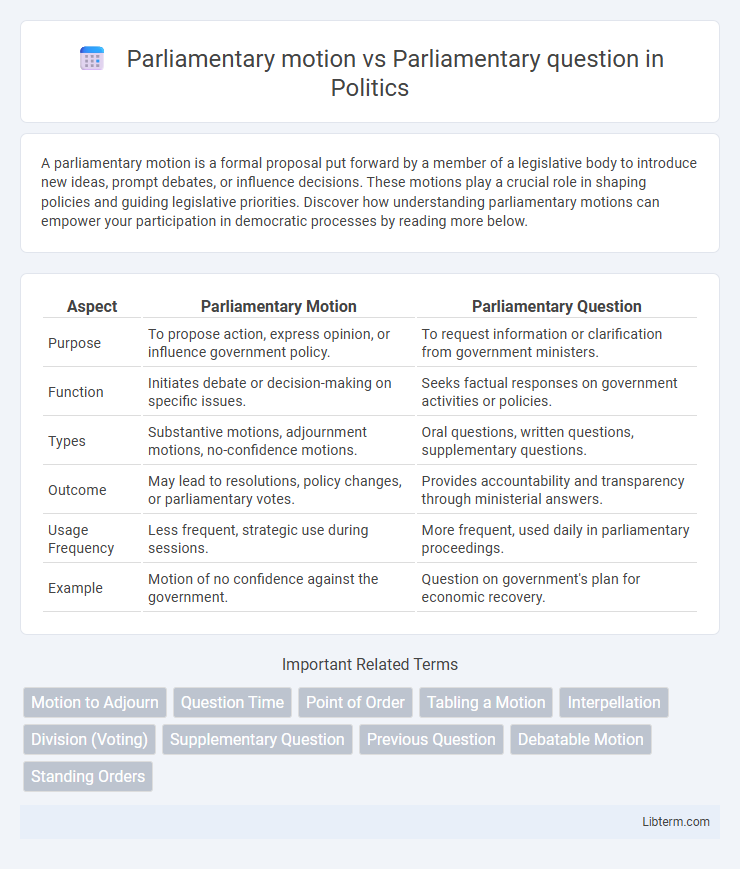A parliamentary motion is a formal proposal put forward by a member of a legislative body to introduce new ideas, prompt debates, or influence decisions. These motions play a crucial role in shaping policies and guiding legislative priorities. Discover how understanding parliamentary motions can empower your participation in democratic processes by reading more below.
Table of Comparison
| Aspect | Parliamentary Motion | Parliamentary Question |
|---|---|---|
| Purpose | To propose action, express opinion, or influence government policy. | To request information or clarification from government ministers. |
| Function | Initiates debate or decision-making on specific issues. | Seeks factual responses on government activities or policies. |
| Types | Substantive motions, adjournment motions, no-confidence motions. | Oral questions, written questions, supplementary questions. |
| Outcome | May lead to resolutions, policy changes, or parliamentary votes. | Provides accountability and transparency through ministerial answers. |
| Usage Frequency | Less frequent, strategic use during sessions. | More frequent, used daily in parliamentary proceedings. |
| Example | Motion of no confidence against the government. | Question on government's plan for economic recovery. |
Introduction to Parliamentary Procedures
Parliamentary motions are formal proposals made by members to introduce new business or express opinions within a legislative body, guiding decision-making processes. Parliamentary questions allow members to seek information or clarification from the government or executive, holding them accountable and ensuring transparency. Both tools are essential elements in parliamentary procedures, structuring debate and maintaining effective governance.
Defining Parliamentary Motions
Parliamentary motions are formal proposals submitted by members of a legislative body to initiate debate or decision on specific issues, policies, or actions. Unlike parliamentary questions, which are inquiries directed at government officials to obtain information or clarify policies, motions actively seek legislative action or changes. Common types of motions include substantive motions, which propose new measures, and procedural motions, which address the conduct of parliamentary business.
Understanding Parliamentary Questions
Parliamentary questions are formal inquiries posed by members of parliament to government ministers, aiming to obtain information about government policies, administration, or current issues. These questions are categorized into oral and written types, with oral questions allowing for immediate responses during parliamentary sessions, while written questions provide detailed answers documented for public record. Understanding parliamentary questions is essential for holding the government accountable and promoting transparency within legislative processes.
Key Differences Between Motions and Questions
Parliamentary motions are formal proposals put forward by members to initiate debates, make decisions, or express the assembly's opinion, whereas parliamentary questions seek information or clarification from government officials. Motions typically require a vote to determine the assembly's stance, while questions aim to hold the executive accountable through direct responses. The key difference lies in their purpose: motions drive action or resolution, and questions facilitate scrutiny and transparency within parliamentary proceedings.
Types of Parliamentary Motions
Parliamentary motions include various types such as substantive motions, which propose new policies or decisions, and procedural motions that address the rules of debate or parliamentary procedure. Examples of procedural motions are motions to adjourn, motions to amend, and points of order, each serving specific functions to manage parliamentary business efficiently. Parliamentary questions, by contrast, primarily seek information or require explanations from government officials without directly altering policy or procedure.
Categories of Parliamentary Questions
Parliamentary questions are categorized primarily into starred, unstarred, short notice, and questions to private members, each serving a specific function in seeking information or pressing issues from the government. Starred questions require oral answers and allow supplementary questions, triggering immediate accountability, while unstarred questions receive written responses. Short notice questions address urgent matters, and questions to private members enable scrutiny beyond the executive branch, fostering comprehensive parliamentary oversight.
Procedures for Submitting Motions
Parliamentary motions are formally submitted proposals that require a written notice, typically presented to the clerk or chairperson before a session begins, often necessitating sponsorship by multiple members. In contrast, parliamentary questions are inquiries posed orally or in writing during designated question periods without prior notice, designed to seek information or hold the government accountable. The procedure for submitting motions involves drafting precise language, adherence to standing orders, and sometimes committee review, whereas questions follow a structured but more flexible process governed by time limits and relevance rules.
Procedures for Raising Questions
Parliamentary questions require members to submit written queries in advance, allowing ministers to prepare accurate responses during sessions. Motions involve formal proposals debated and voted upon to influence legislation or government policy. The procedural rules for raising questions emphasize timely notice and specificity, whereas motions demand detailed drafting and formal introduction on the parliamentary agenda.
Impact on Legislative Processes
Parliamentary motions directly influence legislative processes by formally proposing new laws, amendments, or actions, thereby shaping policy outcomes and driving governmental accountability. Parliamentary questions, while not creating binding changes, serve as crucial tools for scrutinizing government activities, promoting transparency, and informing debate within legislative sessions. The dynamic interplay between motions and questions ensures both proactive law-making and reactive oversight, essential for a balanced parliamentary system.
Conclusion: Choosing Between Motions and Questions
Parliamentary motions serve to propose actions or express opinions, making them suitable for influencing legislative decisions or policies. Parliamentary questions are designed to request information or hold the government accountable without directly prompting immediate action. Selecting between motions and questions depends on whether the goal is to initiate a formal legislative process or to obtain clarity and transparency from government officials.
Parliamentary motion Infographic

 libterm.com
libterm.com